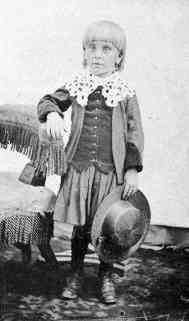
Figure 1.--Occasional images show bangs being worn in the 1870s and 80s. The reklatively limited number of such images, however, suggest that it was not a popular style for boys.


Figure 1.--Occasional images show bangs being worn in the 1870s and 80s. The reklatively limited number of such images, however, suggest that it was not a popular style for boys. |
A popular hair style for children has been bangs. Bangs are a hair cut
with a fringe, usually cut straight, over the forehead. The popularity
of bangs has varies from time tio time. Styles have varied as well as the
view of bangs as either a style for boys or girls. Bangs were popular
at the turn of the centurt, but then began to be viewed as more of a
girls hair cut. Since the Beattles in the 1960s they have been seen more
as a boys' cut and are sometimes worn by even high schoolage boys.
I am not sure just when this hair style first appeared. I have
noted boys earing bangs as early as the 1870s. Based on the
relatively limited number of images, however, it would seem that bangs
were not very popular for boys from affluent families until the turn
of the century. This may, however, be somewhat misleading. I think
farm boys throughout the country had their hair cut by their mothers.
One common method was to use a bowl to cut a straight line. This
led in effect to bangs at the front. These boys in the 19th Century,
however, were probably less likely to have their hair cut.
Doting Victorian and Edwardian mothers kept their treasured sons
in dresses and long curls. As the 19th century passed boys were less
frequently kept in dresses and their hair was cut earlier. It was about
this time that front bangs began to appear on boys. The bangs I have noted which appeared
at about the turn of the century also had longer hair left over the ear
at the side. I am not sure why bangs began to appear at this time or
who promoted the fashion. Perhaps the so called bowl-cut of low-income
families had some impact in popularizing bangs. Using a bowl a boys
hair could be eavenly cut at home, leaving a front fringe, but the hair cut away from the ears.
Bang is not a new word, it appears in the English language in the 16th century. It was not used in connection with a front fringe of hair, however, until the 1870s. I am not sure, however, just
why it was adopted. One source said it was adopted from the adverviable usage of "bang", but HBC is not sure about this. One HBC reader remembers her dad asking if she had swallowed a firecracker. When she answered, "No, why?" Her dad replied, "Because your hair came out in bangs."
One of the major differences in bang cuts was wheter the hair was
cut short enough to reveal the ears. Boys hair was cut both ways. I
have not yet, owver, acquired informatiion on the relative popularity
over times with cuts revealing or covering a boys' ears.
The most common style of ringlet curls for boys in the late 19th century was to wear forehead bangs with ringlets at the side and back. Not all boys wearing ringlets hadcforehead bangs, but it was the most common style.
One not very common hair style for boys involved the curling of a boys
forehead bangs. This could be done even with a boy who did not have
really long hair. It was much more common to let a boys hair grow long and
then curl his hair. In some cases a boy might have shoulder-length hair.
A mother might still curl her son's hair, even if he did not have long
shoulder-length hair. Often thevlonger hair was cut when the boy graduated
from dresses and was breeched. Thus the curling of a boy's forehead bangs
was an option open to a mother
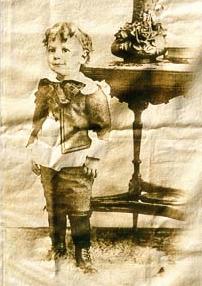
Figure 3.--This boy looks to be about 5 years old. He wears a Fauntleroy suit with curls, even his forehead bangs are curled. The image appears to date to the late 1880s or 1890s. |
This cut is often referred to as Dutch-boy bangs, presumably
this style originated in Holland. I have no historical details
substantating that this was a popular hair style in Holland for boys
or children in general. Perhaps one of our Dutch visitors can provide some background. The smiling Dutch boy corporate logo with his overalls and cap and wooden
shoes is familiar to many Americans. Dutch boy images from the fairy tales--the one who plugged the dike with his finger, are familiar to children.
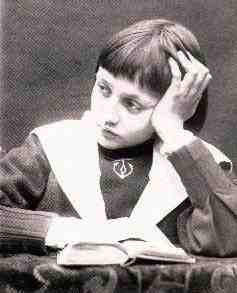
Figure 4.--Dutch boy bangs were worn by boys from many countries. This French boy, the son of Emie Zola, wears bangs in a photograph taken during the late 1890s. |
Dutch boy bangs perhaps became popular after the turn of the century because it allowed some mothers to retain a longish hair style on their boys as the long hair and curls of the late 19th century were passing out of style.
The bangs which appeared at the turn of the century are generally
associated with Buster Brown suits and, to a
lesser extent, Russian blouses. They were,
however, worn with many other styles such as sailor suits, but not as
commonly Fauntleroy suits.
It was always a major rite of passage for a boy to finally have his curls
cut and allowed to wear more closely cropped hair like his father.
Cutting a boys bangs and allowing him to get a short hair cut with a center or side part was
a similar event.
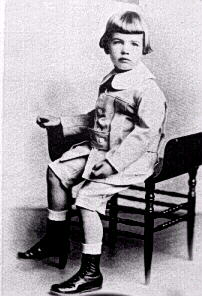
Figure 5.--"Dutch boy" hair cuts with bangs were popular for boys at the turn of the century. This boy wears a kneepants Norfolk suit with short socks. |
Boys also wore bangs with side rolls. Rather than ringlets hanging at the side. The hair was contured at the side in a kind of buldge or roll. This was not a common style, but some boys in the early 20th century sid wear it. While his was a style of long hair, the hair was well off the shoulders.
As long hair and curls for boys went out of style in the 1910s, bang
became increasingly popular--at least for mothers. Boys, at least when
they reached the age that they began to notice such things, preferred
hair cuts more like the ones their dads had. Dutch boy bangs, however,
did not disappear in the 1920s. They were a very
poular hair style for girls of all ages during the 1920s-40s. As so often
happens, girls' adopt a boyish fashion and then the boys no longer
want to wear it. Younger boys were also done up in bangs. This was
especially poular during the 1920s and 30s, but disappeared for boys
in the 1940s, especially for older boys. One recurring them in boys'
fashions is that as soom as little boys and girls adopt a fashion, than
older boys no longer want to wear it. The cut for girls involved
covering the ears. Except for very little boys a boys ears might be allowed to show when his hair was cut with Dutch boy bangs.
Bangs never quite went out of style. Small boys throughout the 20th
century have worn them. John John Kennedys bangs in the early 1960 gave them a renewed standing for small boys. Soon bangs were fashionable again. She was critcised in many quarters for her son's hair cut and she eventually had it trimmed. The style, however, caught on and little boys in bangs wearing shortalls became a common
sight.
It was was not just little boys wearing bangs in the 1960s. Soon after John-John popularized bangs, the Beattles made bangs acceptable for older boys. Throughout the late 1960s and 1970s, boys up to their
mid-teens would wear bangs.
Bangs have not gone completely out of style in the 1990s. Small boys often wear bangs. The stle has also contiued for older boys, but
not quite as popular as in the 1960s and 70s. In addition, the bowl
cut which reappeared in the early
1990s, often involved bangs. The cut had long hair on top and cut at more or less a circular bowl lenhth at the sides with the hair around the ears and neck cut very short.
Many clothing styles were worn with bangs. Perhaps the most common style associated with bangs were Buster Brown tunic suits, but bangs were worn with many other garments as well. Because sailor suits were so pervasive, probably mote boys in bangs wore sailor suits than any other garments. One style that was not commonly worn with Dutch Boyb bangs was Little Fauntleroy suits. Many boys wore Fauntleroy suits with ringlet curls, although often the ringlet styling did involve front bangs.
One problem with bangs are they are not easy to cut. They take a bit of effort to cut and then have to be maintained. This is one factor to consider when assessing the popularity of these hair fashions. It affected who could wear some of these styles. Mothers with largev families could not afford to chose hard to cut and maintain hair styles unless they were an affluenbt family. One father
provided the following guidelines as to an eeasy way of cutting a boys' bangs.
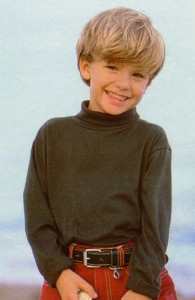
Figure 9.--The classic bangs continue to be one of the most popular style for younger boys. One modern look is the kind of informal, uncombed bangs worn by this boy. |
Bangs continued to be worn by boys. A current popular style is bangs
in front across the forehead worn with a general bowl cut. This is often
worn by blond boys. It is most common with smaller boys, but is often
worn by younger teenagers. While formal straight cut bangs are still
commonly seen on younger boys, a more common style is the sort of stragely
bangs popularized by John-John in thr 1960s. It continues to be a very
popular look in the 1990s. Note the turtleneck this boy wears.
Related Links
Navigate the Boys' Historical Clothing hair style pages:
[Return to the Main hair page]
[Bangs]
[Long hair]
[Ringlet curls]
[Hair bows]
[Curls]
[Hats and caps]
[Collar bows]
Navigate the Boys' Historical Clothing Web Site:
[Introduction]
[Activities]
[Bibliographies]
[Biographies]
[Chronology]
[Clothing styles]
[Contributions]
[Countries
[Boys' Clothing Home]
